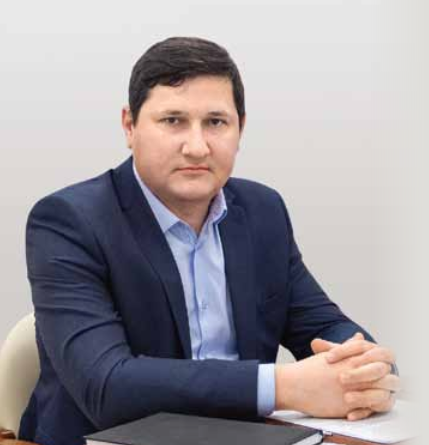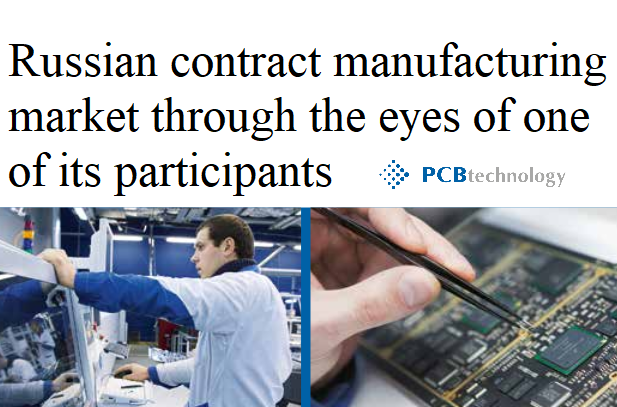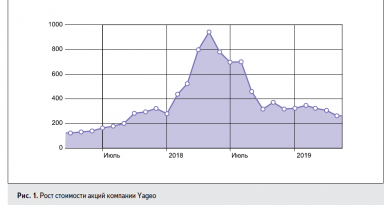Russian contract manufacturing market through the eyes of one of its participants

A.B. Sobolev, General Director of PSB technologies LLC, a well-known contract assembler of electronic devices in the country that also provides design center services for designing printed units and boards for them. This year the company for the first time demonstrated its capabilities to a wide range of European specialists by participating in the international exhibition EmbeddedWorld 2020. Alexander Borisovich Sobolev, General Director of PSB technologies LLC, told us about the significant results of the exhibition for the company and the situation with contract assembly in Russia, the promotion of contract design, the localization of products of foreign manufacturers and his view on state support measures.
Alexander Borisovich, last February your company took part in the EmbeddedWorld 2020 exhibition in Nuremberg. What goals did you set for yourself and how do you evaluate the results? What are your impressions on the exhibition as a whole?
This year’s exhibition unfortunately was not as crowded as expected: some exhibitors withdrew at the last moment, and there were fewer visitors than might have been expected. Nevertheless it made a good impression. It is one of the largest exhibitions for representatives of our field of activity and of course many interesting developments were shown there.
We were located at the MadeinRussia stand next to about fifteen other Russian companies. This was our first experience of participating in foreign events of this type and scale and I consider it successful: about fifty negotiations were held, often short, on the feet and some of them have the prospect of continuing and moving into the direction of practical cooperation.
We have chosen three areas of activity for promotion at the international exhibition: design of printed circuit boards by our design bureau, production of prototypes of electronic components and localization of production of foreign companies in Russia.
The first direction was met with some interest and we exchanged contacts with several similar developer companies. Something real can happen here.
As for making prototypes it will be difficult for us to compete with local manufacturers in this area. In Europe all this is perfectly arranged. The same components – they are always there, and if any item is missing it will be brought from the United States the next day after the order.
We are far from such perfection. The complete set for the product can be assembled in the best case for a week – and this is only what is in the warehouses of suppliers in Russia. The share of this configuration is usually from 50 to 70% of the specification items, the rest must be imported from abroad and this is at least two weeks. Therefore we have come to the conclusion that the production of prototypes for the European market is currently unpromising.
The third direction, localization of production, aroused serious interest of potential customers. Russian-speaking businessmen living in Germany and France were particularly active here. The benefit is clear: if you do not import but collect in Russia, then you do not have to pay duties; and our labor force is relatively inexpensive. However from the point of view of the latter factor we have competitors in the face of Eastern European countries – Romania, Bulgaria and Macedonia also offer contract assembly services quite cheaply.
However when working for the Russian consumer our positions look obviously preferable. I am not talking about mass production but about small series from hundreds to several thousand products. Here we are able to provide good quality, time and service at competitive prices. At the same time we focus on complex projects. That is industrial computers, medical equipment, etc; modules of our production are on the spacecraft and other critical objects. All this was shown at the exhibition and we already have several requests for more detailed negotiations. Just today we’ve received a request from France; we are in correspondence with Nigeria and they also have an interest in cooperation.
How do the problems with the electronic component base (ECB) which you mentioned in relation to the production of prototypes affect localization?
In this case the deadlines are not so tight, the work is going according to plan. There are large suppliers that offer good prices and we, as contractors, also have a discount. So for the task of localization of production configuration is not a fundamental problem.
When you localize the production of products of foreign customers do they require certification of your production base according to their standards or conversely they must certify their products according to Russian requirements?
This is the customer’s task. We offer him our capabilities and he decides what he needs – just cost reduction due to lower assembly costs or full localization which opens up the prospect of participating in large programs with budget funding.
On our side everything necessary has already been provided. Production has certificates according to domestic standards and ISO 9001, we are on the list of domestic manufacturers and one product has already passed through our production as localized. Having experience in preparing the necessary set of documents for the Ministry of industry and trade of Russia we can also help the customer in the organizational aspect of the localization process.
It is also worth noting that a customer who focuses on localization may be particularly interested in our proposals for development and design since these stages of the product creation cycle are highly valued when determining the share of Russian participation in localized production. The increase in the number of orders is largely due to the fact that more and more companies are coming to us to localize their production
The implementation of the tasks set in “The strategy for the development of the electronic industry of the Russian Federation for the period up to 2030” should lead to an increase in the depth of localization up to the ECB. Do you think this will help develop the contract manufacturing market in Russia or will it create some obstacles?
If we talk in general about the installation to replace foreign-made products with domestic ones it certainly creates additional prospects for us since it promises the appearance of new customers. In fact this process is already being observed: many manufacturers come to us for localization, refusing to manufacture their products abroad. And it is almost exclusively Russian producers, the real work with foreign companies we have only just begun.
The question with ECB is not so clear. Today the domestic components are used rarely, mainly ECB for critical products. Purchasing components manufactured in Russia also often creates problems – as a rule they are not available in warehouses, production on order takes a long time and their price is higher than that of imported analogues.
Further in the development of general civil purposes usually foreign ECB is laid and products that are subject to localization are initially built exclusively on it. So we must either organize the production of complete analogues or invite major foreign manufacturers of ECB to build plants in Russia – but will they come here especially in today’s difficult situation?
And our own new-generation ECB? The Strategy contains a requirement for industrial development of silicon microelectronics with a topological norm of 28 nm and then up to 7-5 mm…
Well, there is time, we can expect that this will be implemented. Then there will be developments based on such a component base. But this applies to domestic manufacturers and foreign companies are unlikely to use our components in their projects. So it is doubtful that the new generation of domestic ECB could somehow help the development of localization. There are complaints about the quality of the Russian ECB.
Do you have any complaints about the Russian ECB in terms of quality and technology?
Yes, there are complaints about the quality. And sometimes the opposite happens: for example recently we put inductors of domestic production in one product because technologists gave them preference over foreign analogues. However they were poorly extracted from the tape; I must say problems with packaging are typical for our ECB.
Where do you order the printed circuit boards (PCB) that you use to assemble your products?
This depends on the complexity of the electronic node and accordingly its board. Since we specialize in complex projects our boards are mainly manufactured in South and Southeast Asia. For typical relatively simple products boards can be purchased from Russian manufacturers.
Could you clarify what exactly are unable to provide our manufacturers of printed circuit boards?
If we talk about production capabilities we do not have factories that can produce large series about hundreds of thousands of units. In addition the time frame: Asian companies will complete the order in two to three weeks even if it is a complex project and our company will assign a much longer period.
From a technical point of view, as far as I can judge, the limit for serial production of our plants are boards with a conductor/ gap width of 0.1/ 0.1 mm. Flexible-rigid, hybrid boards, PCB with micro-holes, with blind holes, technologies with multiple pressing cycles – all this is only being worked out, sometimes available as an exclusive product, but in sustainable mass production has not yet been mastered.
Do you think it makes sense for the state to support this direction and develop the production of PCB?
Yes, it should be done. Moreover the relevant government agencies have this understanding and it is not for nothing that domestic PCB, as well as their own development, are one of the significant factors in determining the level of product localization.
Medium-sized and especially small businesses are not able to build a high-tech complex worth several tens of millions of dollars. Several relatively large PCB production facilities that are currently operating successfully rely on public investment. Perhaps this task will be taken over by big business; in any case the creation of modern PCB production must rely on strong financial support to survive a long payback period and win its market share pushing out the dominant foreign manufacturers today.
What kind of government assistance would you like to receive for your company?
Discounts on income tax, insurance deductions and compensation for interest on loans when purchasing equipment under production development programs would be useful. If the economic situation remained normal, there were customers, these three types of support would be sufficient for stable operation and maintaining the proper technological level.
Do you use the services of development funds?
Rarely. For example 80% of the cost of participating in EmbeddedWorld was compensated by the Russian export center. There was compensation for the purchase of professional software CadenceAllegro, Sigrity and CAM350. In 2011 we received assistance with interest on loans for the purchase of equipment. That’s about it.
Do you plan to develop production with capital investment? Maybe this is stimulated by the growing requirements of customers for microminiaturization? Is there a need to replace or supplement the equipment in connection with the adoption of the regulation TR EEU 037/ 2016 which contains requirements for lead-free soldering?
We have been producing products using lead-free technology for a long time, we can install all components from size 01005 – until now there was no situation that we could not assemble the printing unit as needed by the customer. Therefore at the moment we are only considering point replacements to improve efficiency: we are thinking of replacing one of the two AOI – the older one; we will probably change our very first installer along with the printer.
It can also be noted that we are constantly working to increase the degree of automation of production and its management. We are currently updating to the latest version of the SAP BusinessOne system, which we have been working with for a long time, in order to minimize errors, automate work with fixable defects and generally speed up the production process.
The traditional question for a contract manufacturer is: what is the level of technology of the projects that customers come to you with? How much do their designers take into account the capabilities of your technology and equipment?
We have mostly qualified customers. Projects are complex, they work with them carefully, try to take into account everything necessary. If something does not meet our requirements, we give recommendations, customers quickly get used to them and problems no longer arise.
In addition we regularly conduct seminars on DfM which also contributes to improving the quality of incoming projects.
How popular is the contract design service among Russian companies? After all this is our well-known feature – managers try to focus the entire cycle of product creation and even more so-the development stage.
Our design bureau has been working for more than 10 years. Its specialists are highly professional and have vast experience. We meet all the customer’s requirements, meet all the technological standards, we align the tires and calculate the impedances, conduct modeling and it often happens that once a project is put into production we immediately get a working prototype.
But it is really not easy to convince the customer to outsource the design of printed units. In addition to the desire to fully control the entire process many companies have a large staff of designers and constructors and this also becomes an obstacle when making a decision to transfer the development to a third-party organization.
However more and more customers are beginning to realize that it is cheaper to order the design to us especially if their design departments do not have a regular load. The number of design orders we receive is gradually increasing and I think this trend will only increase in the future.
How do you see the company’s immediate future?
In the last three years we have shown good growth: compared to 2016 in 2019 sales increased 2.5 times, in 2019 alone – by 50%; we have started working full-time in two shifts. We hope this process will continue. State incentives to localize production should help with domestic orders. We expect real results from our efforts to attract foreign companies. It is unclear how the situation will develop but there is a desire to participate in the electronica exhibition in Munich – there is a whole hall dedicated to the theme of contract production.
In General we look forward to the development of the Russian contract manufacturing market in general and our company in particular.
Thanks for the interesting story.
With A.B. Sobolev interviewed Y.S. Kovalevsky, G.A. Loginova and V.E. Meylitsev.
Electronics science| technology| businessNo3 (00194) 2020

